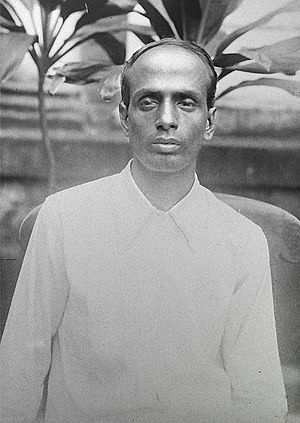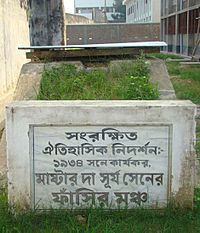Chittagong armoury raid facts for kids
The Chittagong armoury raid, also known as the Chittagong uprising, was a brave attempt on April 18, 1930. A group of young Indian freedom fighters, led by Surya Sen, tried to take over the police and army weapons storage (armoury) in Chittagong. This city was then part of British India and is now in Bangladesh. The goal was to fight for India's independence from British rule.
Contents
Who Were the Freedom Fighters?
The people who took part in this raid were members of the Indian Republican Army. They believed that armed uprisings were the best way to make India free from British colonial rule. They were inspired by the 1916 Easter Rising in Ireland. Their leader was Surya Sen, often called "Masterda" (meaning "teacher" in Bengali). Many of these fighters were also influenced by Communist ideas.
Some of the important members of this group included Ganesh Ghosh, Lokenath Bal, Ambika Chakrobarty, Ananta Singh, Pritilata Waddedar, and Kalpana Dutta. These young people were ready to risk everything for their country's freedom.
What Was the Plan?
Surya Sen and his group made a detailed plan. They wanted to capture two main armouries in Chittagong to get weapons. They also planned to destroy the telegraph and telephone offices. This would stop people from communicating and calling for help.
Another part of the plan was to cut off Chittagong from Calcutta by damaging railway lines. They also hoped to take members of the European Club as hostages. This club was a place where British officials gathered. The revolutionaries also planned to get money from banks to help fund future uprisings. They even hoped to free other revolutionaries who were in jail.
The Raid Begins
The plan was put into action at 10:00 PM on April 18, 1930. One group, led by Ganesh Ghosh, successfully captured the police armoury. Another group of ten men, led by Lokenath Bal, took over the Auxiliary Forces armoury. About 65 people took part in this raid.
They called themselves the Indian Republican Army, Chittagong Branch. While they managed to take the armouries, they couldn't find the ammunition they needed. However, they did succeed in cutting telephone and telegraph wires. They also managed to stop trains from moving, cutting off Chittagong from the outside world.
About 16 members of the group went to the European Club. But there were not many club members there because it was Good Friday. The Europeans quickly realized what was happening and managed to alert the troops. This was something the revolutionaries had not expected.
After the raids, the revolutionaries gathered outside the police armoury. Surya Sen took a military salute and raised a national flag. He then announced the formation of a temporary revolutionary government. Before dawn, the revolutionaries left Chittagong town. They marched towards the Chittagong hills, looking for a safe place to hide.
The Aftermath and Resistance
A few days later, the police found some of the revolutionaries. On April 22, 1930, they were surrounded by thousands of troops in the Jalalabad hills. A gunfight broke out, known as the Battle of Jalalabad Hills. Many troops and 12 revolutionaries lost their lives. Surya Sen told his men to scatter into small groups and hide in nearby villages. This way, some managed to escape.
Some revolutionaries fled to Calcutta, while others were arrested. The British authorities began a strong crackdown on the resistance. Ananta Singh later gave himself up in Calcutta to be near the young teenagers who were arrested and on trial. A few months later, Police Commissioner Charles Tegart found another hideout. In a gunfight there, Jiban Ghoshal was killed.
Some of the revolutionaries managed to regroup and continue their fight. On September 24, 1932, a group led by Pritilata Waddedar attacked the Pahartali European Club again. One woman was killed, and several police officials were injured. Pritilata Waddedar was a brave young woman who later died during this attack.
Between 1930 and 1932, revolutionaries were responsible for the deaths of 22 officials and 220 other people in different incidents.
The Trial and Sentences
The trial for those arrested during and after the raids ended in January 1932. The final decision was given on March 1, 1932. Twelve of the accused were sentenced to be sent away for life. Two received three-year prison sentences. The remaining 32 people were found not guilty.
The twelve who were sent away for life included Ganesh Ghosh, Lokenath Bal, and the sixteen-year-old Ananda Gupta. They were sent to the Andaman Islands, a remote place used as a prison.
Capture and Death of Surya Sen
The Chittagong revolutionary group faced a big setback when Masterda Surya Sen was arrested on February 16, 1933. He was caught in Gairala village after someone from his own group gave him away. This person, named Netra Sen, told the British authorities where Surya Sen was, hoping for a reward. However, Netra Sen was killed by the revolutionaries before he could get the money.
Surya Sen was a true hero to many. He was hanged by the British government on January 12, 1934. His sacrifice inspired many others in the fight for India's freedom.
Films About the Raid
The story of the Chittagong armoury raid has been told in several movies:
- A Bengali movie called Chattagram Astragar Lunthan was made in 1949. It was directed by Nirmal Chowdhury.
- A Hindi movie, Khelein Hum Jee Jaan Sey, was made in 2010. It was directed by Ashutosh Gowarikar and starred Abhishek Bachchan and Deepika Padukone. This movie was based on a book called Do and Die: The Chittagong Uprising 1930-34 by Manini Chatterjee.
- Another film, Chittagong, was also made in 2010 and released in October 2012. It was directed by Dr. Bedabrata Pain, who used to be a scientist at NASA. He left NASA to make this film. Manoj Bajpai played the main role of Surya Sen.




